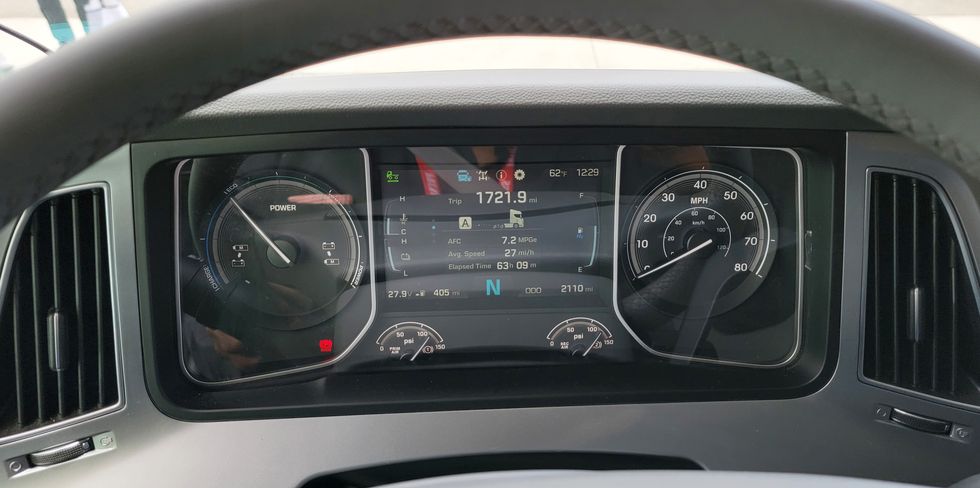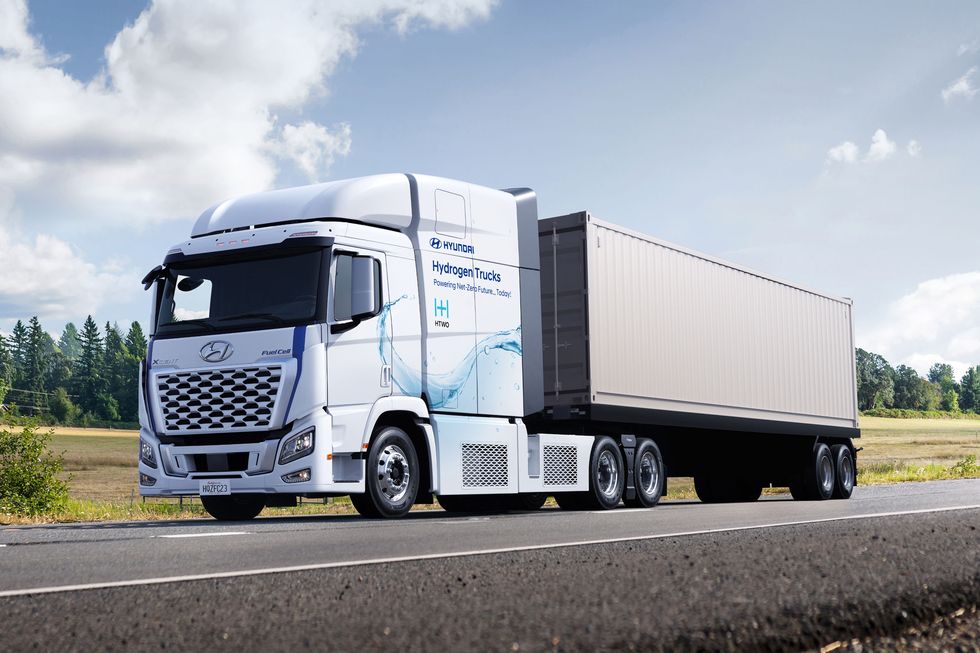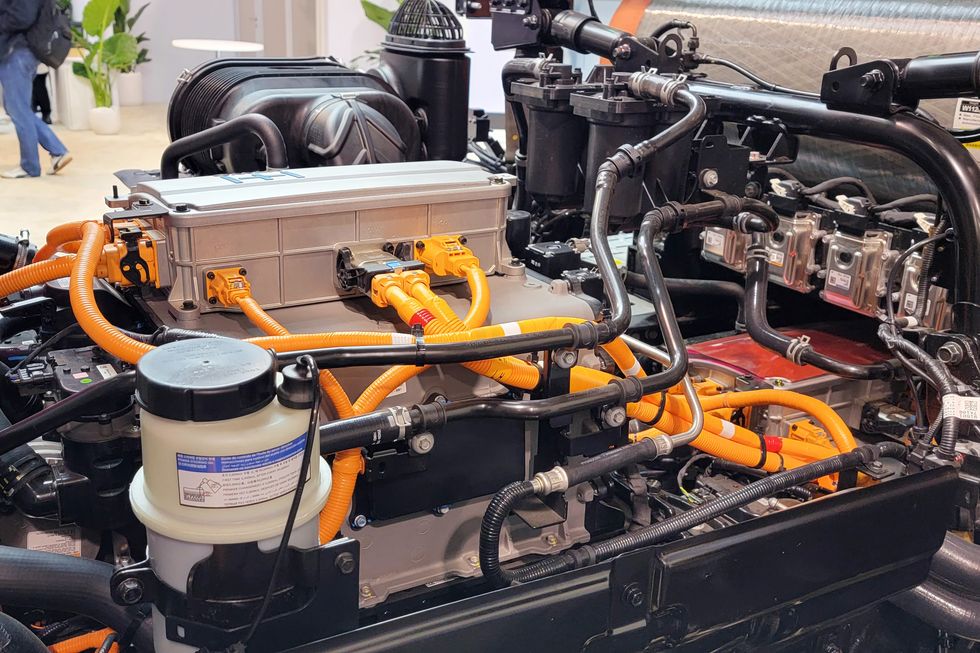Hyundai XCIENT Class 8 Truck Gives Hydrogen a Place to Shine

Now that battery-electrics appear firmly plugged into the transportation grid, hydrogen fuel-cell electric vehicles (FCEVs) benefit from the shortest odds for wide adoption they’ve ever known. That’s still no guarantee, however. General Motors built the hydrogen-fuel-cell Electrovan in 1966, yet at no time in the last 57 years has the most common element in the universe merited even the notional optimism of “give it five years to take hold.”
But that countdown timer might be counting down, finally. The Advanced Clean Transportation Expo in Anaheim, California, recently gathered all the bettors among the alt-fuel ranks. The refrain from everyone we spoke to, when it comes to trucking, was “Hydrogen is here.”
Hyundai is placing its first bet with the XCIENT, a Class 8 tractor on sale now and entering fleet duty at the Port of Oakland this summer. The XCIENT FCEV adapts the hard points of the existing, diesel-powered XCIENT semi that has been sold worldwide since 2013. This explains some of the old-school bits tucked among the new tech that helped get the XCIENT to market quickly.
Jonathan Ramsey|Car and Driver
How Hyundai’s Hydrogen Fuel-Cell Truck Works
Ten hydrogen tanks are arranged two-up in a frame behind the cab, rising to nearly the 13-foot height of the tractor’s roof fairing. The tanks hold a volume of a little over 462 gallons of compressed hydrogen at over 10,000 psi, totaling 151 pounds of fuel. Refilling from empty takes about 30 minutes. The tanks feed two hydrogen fuel-cell systems under the cab, effectively the same units found in the Hyundai Nexo FCEV crossover. Adaptations focused on bracing components for the rigors of a Class 8 duty cycle. Each system contains two 121-hp stacks, for a combined output of 483 horsepower.
As we wrote in our fuel-cell primer, stacks perform best at a steady power output. Automakers address this by using the fuel-cell system to charge a high-voltage, low-capacity battery that powers the electric motors turning the wheels. In the XCIENT, the systems power a high-voltage, fairly high-capacity battery. The Nexo’s lithium-ion pack has a 40.0-kWh capacity, while the three 24.0-kWh lithium-ion packs in the XCIENT equal a total of 72.0 kWh.
The pack’s frame bolts to the passenger-side frame rail, opposite the cooling apparatus attached to the driver-side rail. Nestled in the rails between them sits an electric motor making 469 horsepower and 1650 pound-feet of torque. (By comparison, a diesel XCIENT makes up to 512 horsepower and 1844 pound-feet.)

Jonathan Ramsey|Car and Driver

Jonathan Ramsey|Car and Driver
The motor hooks up to an Allison six-speed automatic transmission. Since the XCIENT’s top driven speed is just 57 mph, the truck only uses the first five cogs in the box. We specify “driven” because a cruise-control offset feature allows the rig to reach 9 mph over the cruise speed when going downhill, so the gravity-assisted top speed is 66 mph. The transmission housing contains a mechanical retarder that helps slow the truck when the battery is full and regen braking can’t be employed. Future evolutions will eventually do away with the traditional gearbox and put electric motors on the axles, eliminating the mechanical retarder and improving regen performance.
A driveshaft turns both tandem axles in back, creating the 6×4 drivetrain that’s the norm for U.S. over-the-road Class 8 trucks. With full tanks and when loaded to the 82,000-pound gross combination weight limit for electric tractor-trailers, Hyundai claims the XCIENT can go 450 miles. Hyundai and other FCEV commercial vehicle makers say the benefit isn’t only that these miles will be far kinder on the environment compared to miles put down via diesel, they’ll be far kinder to drivers as well.
Driving the Hyundai XCIENT Hydrogen Fuel-Cell Truck
First, drivers must make the unexpectedly high ascent into the cab. The U.S. market has preferred conventional trucks, the kind with engines out front, which have a lower cab floor. In a cab-over like the XCIENT, where the body needs to clear the whole height and width of the engine, getting seated is like climbing a ship’s ladder to a bosun’s chair.

Hyundai
A familiar truck layout greets those who reach the summit. Analog gauges in the cluster flank a central screen displaying vehicle information. A small infotainment display in the center console is angled toward the driver. On the steering wheel and dash, multiple rows of buttons manage functions such as changing airbag pressure, activating convenience features such as hill-hold assist, cycling through the infotainment, and controlling the HVAC.
Two stalks emerge from the right side of the steering column. Move the upper stalk up and down to shuffle through the four levels of regenerative braking, and it can also be pushed or pulled to select the highest gear allowed. (When descending a long hill, setting third gear as the maximum caps the truck’s speed with regeneration rather than the friction brakes.) The lower stalk is the shift lever; turning the knob at the end of the stalk changes gears.
Our six-mile test drive encompassed two rectangular laps around Anaheim’s city streets. The XCIENT’s only foible made itself apparent before we left the parking lot: brake-pedal programming. The first smidgen of travel didn’t seem to have any effect, followed by every brake pad latching onto its drum with haste. Cab-overs naturally jiggle a lot more than the conventional rigs we’re used to, being hinged at the front bumper and lacking the damping effect of six feet of engine ahead of the bulkhead. Combined with the abrupt brake actuation, only once did we manage to slow down or come to a stop without making the XCIENT shimmy.

Jonathan Ramsey|Car and Driver
In every other way, the test drive presaged vastly more pleasant workdays for truckers. Driving a turbodiesel big rig is to be submerged in urgent noise, vibration, and harshness for the 11 hours a day that federal law allows truck drivers to spend behind the wheel. If the truck must run while parked, the NVH becomes a lullaby for the day’s remaining 13 hours.
The result is that all the soothing advantages credited to electric cars count exponentially more for heavy trucks and their pilots. The XCIENT’s idling, driving, and robust acceleration at every speed are accompanied only by the occasional muted whine, easily ignored. Conversations can be held at a natural volume, a marvel in a big rig. The XCIENT is so carlike and easy to drive, in fact—just mind your mirrors and the turning circle—that its truck-size steering wheel feels comically large. We also drove the Nikola TRE FCEV Class 8 truck and a BYD battery-electric Class 8 in Anaheim, and one afternoon made it clear that electric trucks are outstanding as both workplaces and beasts of burden.

Jonathan Ramsey|Car and Driver
Those outside the truck benefit too. Hyundai is focusing first on the drayage market, which offers short, regular routes anchored at industrial locations suitable for hydrogen refilling stations. Drayage trucks spend a lot of time idling in residential areas around ports while they wait their turn to grab a load. Hydrogen power silences the cacophony local citizens have been forced to listen to and also improves the air those folks breathe.
Hyundai hasn’t said yet how much the new XCIENT costs. It will say that it expects current state and federal clean-vehicle subsidies to put the XCIENT FCEV at cost parity with current diesel models over a service life of six to eight years. That’s good news for fleets, for truck drivers, and for residents in areas with lots of truck traffic.







